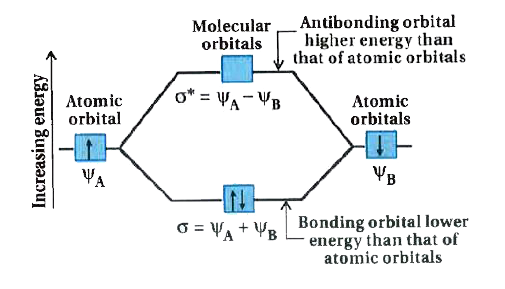Explain Linear combination of atomic orbitals by suitable example
OR
Exaplain H2 molecule by molecular orbitals theory.
LCAO Method of molecular orbitals : Molecular orbital is not obtained by Schrodinger want equation but it can be obtain by LCAO.
LCAO method for Hydrogen Molecule (H2) :
drogen is homonuclear diatomic molecule consider the hydrogen molecule (H2) consisting of two atoms HA and HB.
Mathematically, the formation of molecular orbitals may be described by the linear combination of atomic orbitals that can take place by addition an by subtraction of wave functions of individual atomic orbitals as shown below.
ΨMO=ΨA+ΨB OR Ψ∗MO=ΨA−ΨB
following fig. depicted the formation of H2 molecule from H2 atom and its energy.

Bonding molecular orbital (ΨMO) e.g. σ: the molecular orbital σ formed by the addition of atomic orbitals is called the bonding molecular orbital (ΨMO). Here σ type molecular orbital .
ΨMO=σ(H2)=Ψ2+ΨB
Antibonding molecular orbital (Ψ∗MO) e.g σ∗ : The molecular orbital σ formed by the substraction of atomic orbital (ΨAandΨB) is called antibonding molecular orbital. Here σ∗ type anitbonding molecular orbital.
Ψ∗MO(H2)=σ∗ type antibonding molecular orbital,
Ψ∗MO(H2)=σ∗(H2)=ΨA−ΨB
Topper's Solved these Questions
- CHEMICAL BONDING AND MOLECULAR STRUCTUREBOOK - KUMAR PRAKASHANCHAPTER - CHEMICAL BONDING AND MOLECULAR STRUCTUREEXERCISE - TRY YOUR SELF-3
1 Videos
- CHEMICAL BONDING AND MOLECULAR STRUCTUREBOOK - KUMAR PRAKASHANCHAPTER - CHEMICAL BONDING AND MOLECULAR STRUCTUREEXERCISE - TRY YOUR SELF-4
1 Videos
- CLASSIFICATION OF ELEMENTS AND PERIODICITY IN PROPERTIES BOOK - KUMAR PRAKASHANCHAPTER - CLASSIFICATION OF ELEMENTS AND PERIODICITY IN PROPERTIES EXERCISE - Section -D SOLUTIONS OF NCERT EXEMPLAR PROBLEMS (Long Answer Type Questions )
7 Videos
Similar Questions
(a) What is linear combination of atomic orbitals ?
(b) illustrate bonding and antibonding molecular orbitals based on homonuclear dihydrogen molecule.
View Solution(a) What is linear combination of atomic orbitals ?
(b) llustrate bonding and antibonding moleular orbitals based on homonuclear dihydrogen molecule.
View Solution
Knowledge Check
Molecular orbital theory as developed by Hund and Mulliken concerns with the formation of molecular orbitals formed by linear combination of atomic orbitals. The electrons are present in these molecular orbitals. The molecular orbitals are filled. The molecular orbital configuration helps us to calculate bond order which gives information about the number of bonds present between atoms. The bond order is related to bond length and bond strength.
Which of the following combination does ot give σ MO (assume Z - axis as internuclear axis)A2px+2pxB2pz+2sC2s+2sD2pz+2pzMolecular orbital theory as developed by Hund and Mulliken concerns with the formation of molecular orbitals formed by linear combination of atomic orbitals. The electrons are present in these molecular orbitals. The molecular orbitals are filled. The molecular orbital configuration helps us to calculate bond order which gives information about the number of bonds present between atoms. The bond order is related to bond length and bond strength.
Which one of the following does not have single electron in a bonding molecular orbital?ACNBB2CNODN+2Molecular orbital theory as developed by Hund and Mulliken concerns with the formation of molecular orbitals formed by linear combination of atomic orbitals. The electrons are present in these molecular orbitals. The molecular orbitals are filled. The molecular orbital configuration helps us to calculate bond order which gives information about the number of bonds present between atoms. The bond order is related to bond length and bond strength.
Which of the following will have maximum number of electrons in antibonding MOs?AN+2BO+2CF2DBe2
Explain the diamagnetic behavior of F2 molecule on the basis of molecular orbital theory.
View SolutionExplain the diamagnetic behaviour of F2 molecule on the basis of molecular orbital theory.
View SolutionAccording to MOT, two atomic orbitals overlap resulting in the formation of molecular orbital formed. Number of atomic orbitals overlapping together is equal to the molecule orbital formed. The two atomic orbital thus formed by LCAO (linear combination of atomic orbital) in the phase or in the different phase are known as bonding and antibonding molecular orbitals respectively. The energy of bonding molecular orbital is lower than that of the pure atomic orbitals by an amount Δ. This known as the stabilization energy. The enerby of antibonding molecular orbital in increased by Δ' (destabilisation energy).
Q. which of the following combination of orbitals is corrects?
View SolutionMolecular orbital theory as developed by Hund and Mulliken concerns with the formation of molecular orbitals formed by linear combination of atomic orbitals. The electrons are present in these molecular orbitals. The molecular orbitals are filled. The molecular orbital configuration helps us to calculate bond order which gives information about the number of bonds present between atoms. The bond order is related to bond length and bond strength.
Which of the following is expected to have largest bond length?
View SolutionAccording to MOT (Molecular Orbital Theory), the molecular orbitals are formed by mixing of atomic orbitals through LCAO (linear combination of atomic orbitals). The correct statement(s) about molecular orbitals is/are
Statement (A) : Bonding molecular orbitals are formed by addition of wave-functions of atomic orbitals of same phase
Statement (B) : Anti-bonding molecular orbitals are formed by subtraction of wave-functions of atomic orbitals of same phase
Statement (C) : Non-bonding molecular orbitals do not take part in bond formation because they belong to inner shells
Statement (D) : Anti-bonding molecular orbitals provide stability to molecules while bonding molecular orbitals make the molecules unstable.
View Solution
